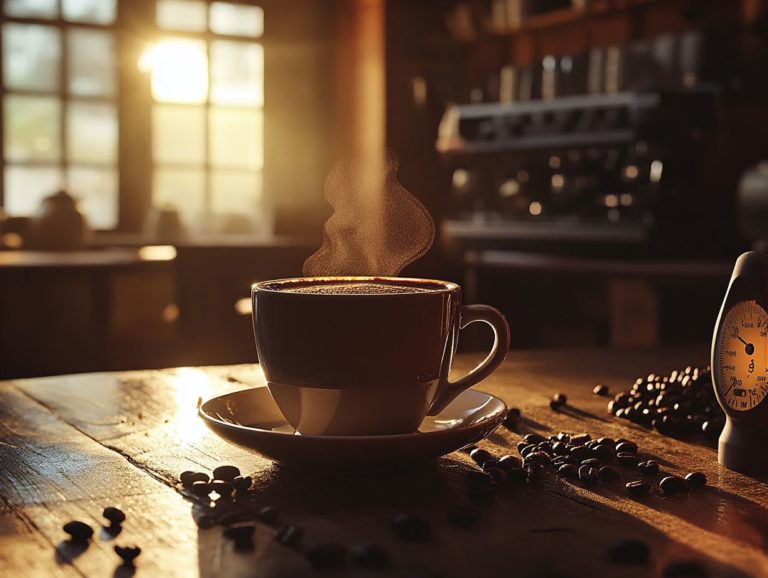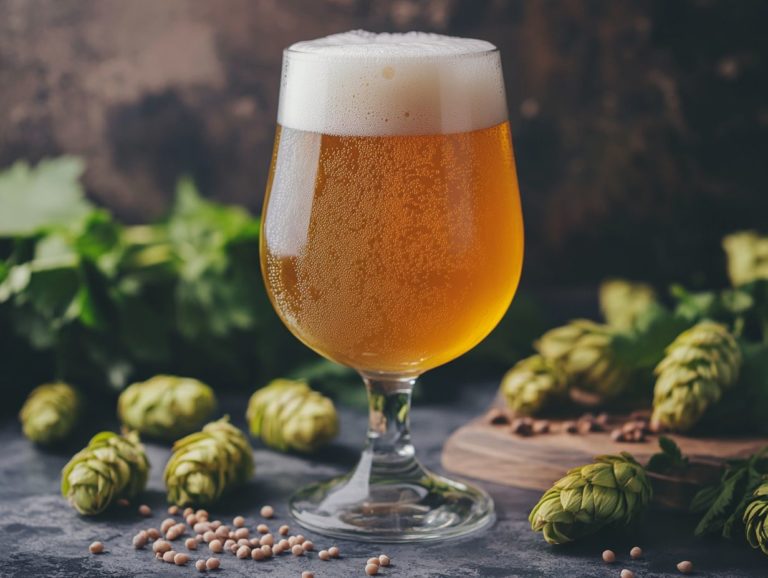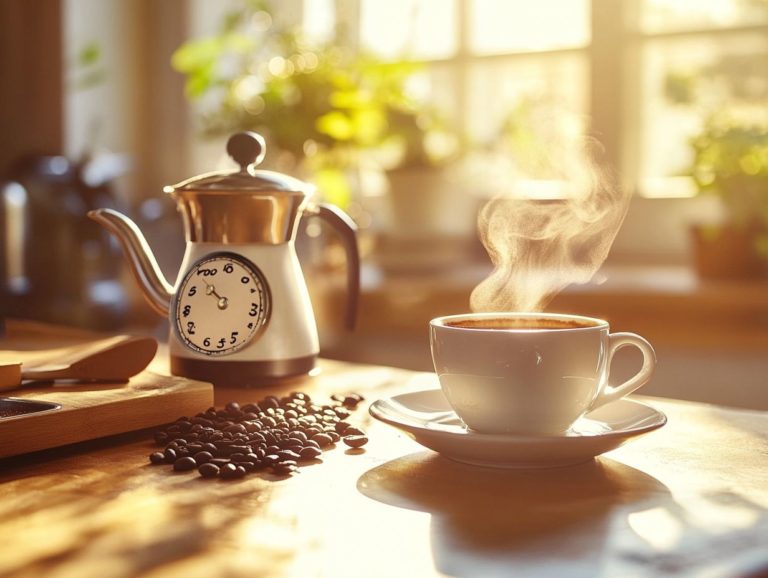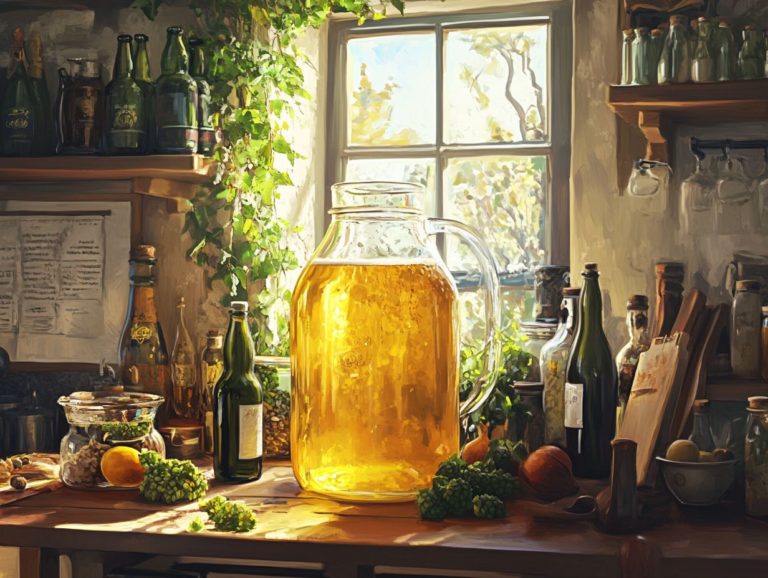What Is the Shelf Life of Home Brewed Beer?
Home brewing has emerged as a delightful hobby, offering enthusiasts the chance to craft their own unique beers right in their homebrew setups or even in small-scale nano breweries.
Once you’ve perfected that batch, you might wonder how long you can expect it to last. Understanding the shelf life of your home brewed beer is crucial for preserving its flavor and quality.
This guide delves into the brewing process, examines the factors that impact shelf life, and provides you with tips to keep your creations as fresh as possible.
You’ll discover how to recognize the signs that your beer has gone bad and explore effective methods to extend its longevity.
Whether you’re just starting out or you re a seasoned brewer, this information will elevate your home brewing experience to new heights.
Contents
- Key Takeaways:
- What is Home Brewing?
- How is Beer Made at Home?
- What Are the Factors That Affect the Shelf Life of Home Brewed Beer?
- What is the Average Shelf Life of Home Brewed Beer?
- How Can You Tell if Your Home Brewed Beer Has Gone Bad?
- Assessing Home-Brewed Beer Quality
- 3. Taste
- How Can You Extend the Shelf Life of Your Home-Brewed Beer?
- 1. Proper Sanitation
- 2. Proper Storage
- 3. Adding Preservatives
- Frequently Asked Questions
- What Is the Shelf Life of Home Brewed Beer?
- How long does home brewed beer typically last?
- What factors can affect the shelf life of home brewed beer?
- Does the type of beer affect its shelf life and beer longevity?
- How can I extend the shelf life of my home brewed beer and bottled beer?
- What are the signs that my home brewed beer or bottled beer has gone bad?
Key Takeaways:
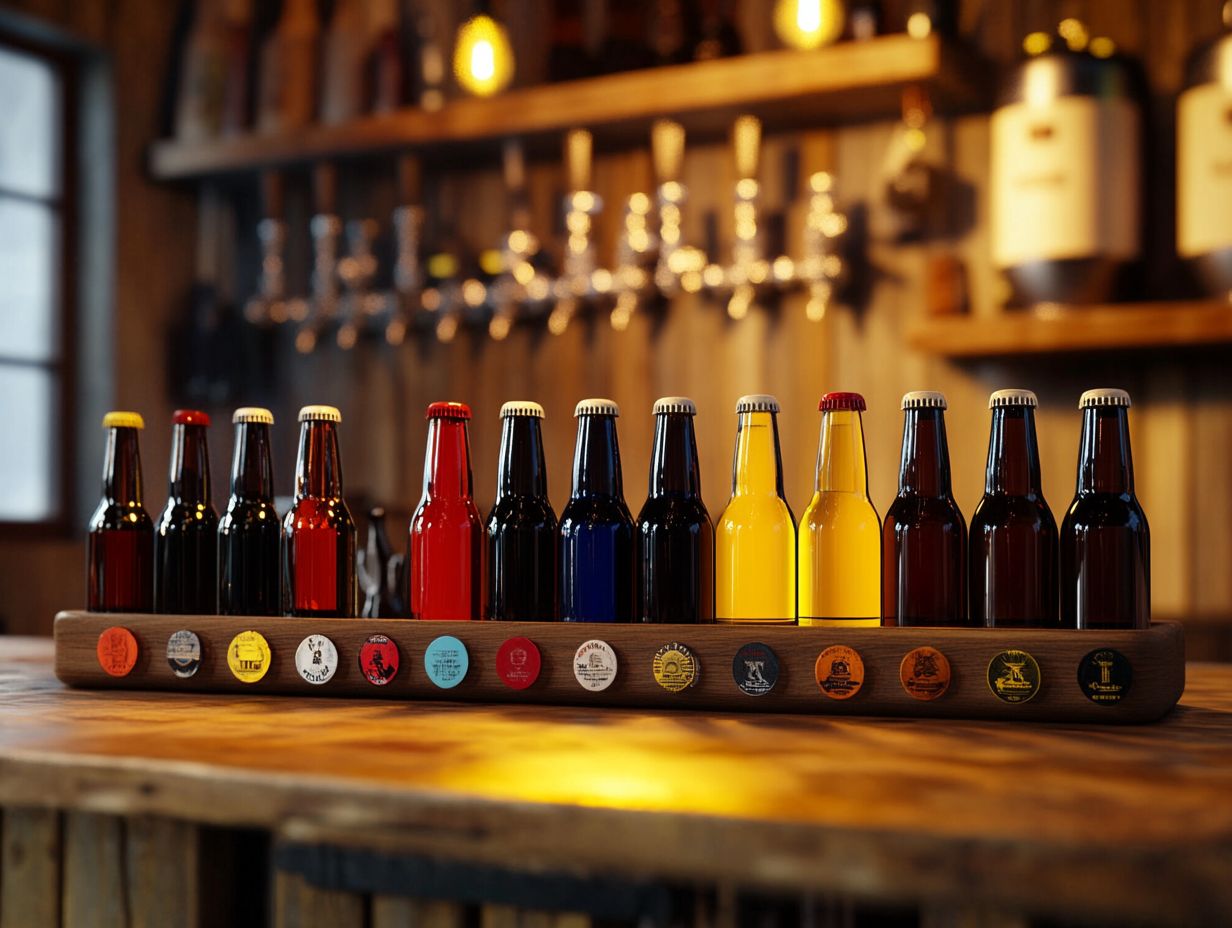
- The shelf life of home brewed beer is influenced by ingredients, brewing process, and storage methods. Proper storage and best practices can significantly extend its longevity.
- The average shelf life for bottled beer is 6-12 months, while kegged beer can last up to 4 months. Using plastic bottles can impact aging differently than glass bottles.
- To determine if your home brewed beer has gone bad, look for changes in appearance, smell, and taste these are key indicators.
What is Home Brewing?
Home brewing is both an art and a science, inviting you to craft your own beer right in the comfort of your home. This exciting endeavor allows you to delve into a variety of brewing styles.
You can experiment with distinct hop flavors, and play around with fermentation techniques and ingredient combinations. Famous beer enthusiasts like Martyn Cornell have documented brewing traditions that date back centuries, like the 1875 Burton Ale.
Not only does it cultivate a sense of community among fellow beer enthusiasts, but it also unveils the intricate brewing processes that produce a remarkable array of beer types.
From Belgian ales to IIPAs and rich barleywines, this community often shares insights on beer development and the nuances of brewing complex beers.
As you embark on this journey, you ll find yourself developing unique brewing recipes, deepening your appreciation for the complexities of beer making and tasting, and discovering its cultural significance along the way.
How is Beer Made at Home?
You can craft your own beer at home through careful brewing steps that encompass several essential steps, beginning with the careful selection of ingredients and culminating in fermentation and bottling.
Companies like Great Fermentations offer brewing kits to help you get started. With a home brewing kit in hand, you have the freedom to explore various brewing recipes tailored to your unique taste preferences.
Whether that means venturing into high-alcohol beers or tackling more intricate styles like imperial stouts and bourbon barrel porters, you’ll need to pay close attention throughout this exciting process.
This process demands your attention to detail, especially regarding fermentation and carbonation levels, to ensure you achieve the beer quality you desire. Pay attention to brewing techniques and fermentation notes for the best results.
What Are the Factors That Affect the Shelf Life of Home Brewed Beer?
The shelf life of your home-brewed beer is shaped by several key factors, including the ingredients you select, the brewing process you follow, and the storage conditions in which you store it.
Proper beer storage involves keeping your brew in a dark room to avoid flavor degradation. Understanding these variables is vital to preserving the quality of your creations.
Whether you’re storing bottled beers, IIPAs, or robust dark beers like barleywines, elements such as oxidation, carbonation levels, and sanitation practices play a significant role in determining the overall quality and flavor stability of your beer as time goes by.
1. Ingredients Used
The ingredients you choose for home brewing malt, hops, yeast, and water have a profound impact on the final product, shaping everything from hop aroma to the complexity of flavors.
Different brewing styles, whether it s a rich Belgian ale or a refreshing American wheat, can result in distinctive taste profiles. Specific ingredients, such as high alcohol content or specialty malts, can create strong ales or intricate beers like Russian Imperial Stouts (RIS) and Barleywines (BWs). Brewers like Elijah at Brewing Boilerman have perfected the use of these ingredients in their 8-month homebrew projects.
Take malt, for example. It not only adds sweetness and color to your beer but also plays a vital role in its body and mouthfeel.
Hops, on the other hand, bring bitterness and a delightful array of aromatic notes that can range from zesty citrus to earthy pine.
Then there’s yeast this tiny powerhouse of fermentation varies immensely between styles. Belgian yeast strains can impart fruity and spicy nuances, while lager yeasts yield cleaner, crisper profiles. Breweries in Indianapolis, such as Great Fermentations, offer a range of yeast options for experimental homebrewers.
Don’t forget about water quality. The mineral content in your water can significantly influence characteristics like bitterness and overall palate balance.
It s fascinating how each ingredient is interdependent, working together to achieve the perfect outcome in your brewing process.
2. Brewing Process
The brewing process unfolds through several essential stages, including mashing, boiling, and fermentation, each playing a pivotal role in shaping the quality and characteristics of your final beer.
During fermentation, yeast works its magic by converting sugars into alcohol, making this stage crucial for developing those complex flavors and aromas, particularly in higher alcohol by volume (ABV) beers like IIPA and barleywine. Great Fermentations and other brewing communities often share tips on perfecting these stages.
Don t underestimate the nuances of these phases; each step uniquely contributes to the end product.
Take mashing, for instance. This is where grains steep in hot water to extract fermentable sugars a delicate dance of temperature and timing that can significantly influence the residual sweetness and body of your beer.
Next comes boiling, where you introduce hops, adding both bitterness and aromatic qualities. The timing and variety of hops you choose can dramatically shift the flavor profile.
This boiling stage is also crucial for achieving the right hop aroma; an important aspect of the brewing process.
Then, fermentation takes the spotlight as different yeast strains impart distinct characteristics. Experience the magic of fermentation! For example, using ale yeast enhances fruity esters, while lager yeast delivers a cleaner taste.
Variations in fermentation temperature can further refine the final profile, showcasing the true artistry of brewing.
3. Keeping Your Brew Safe: Sanitation and Storage
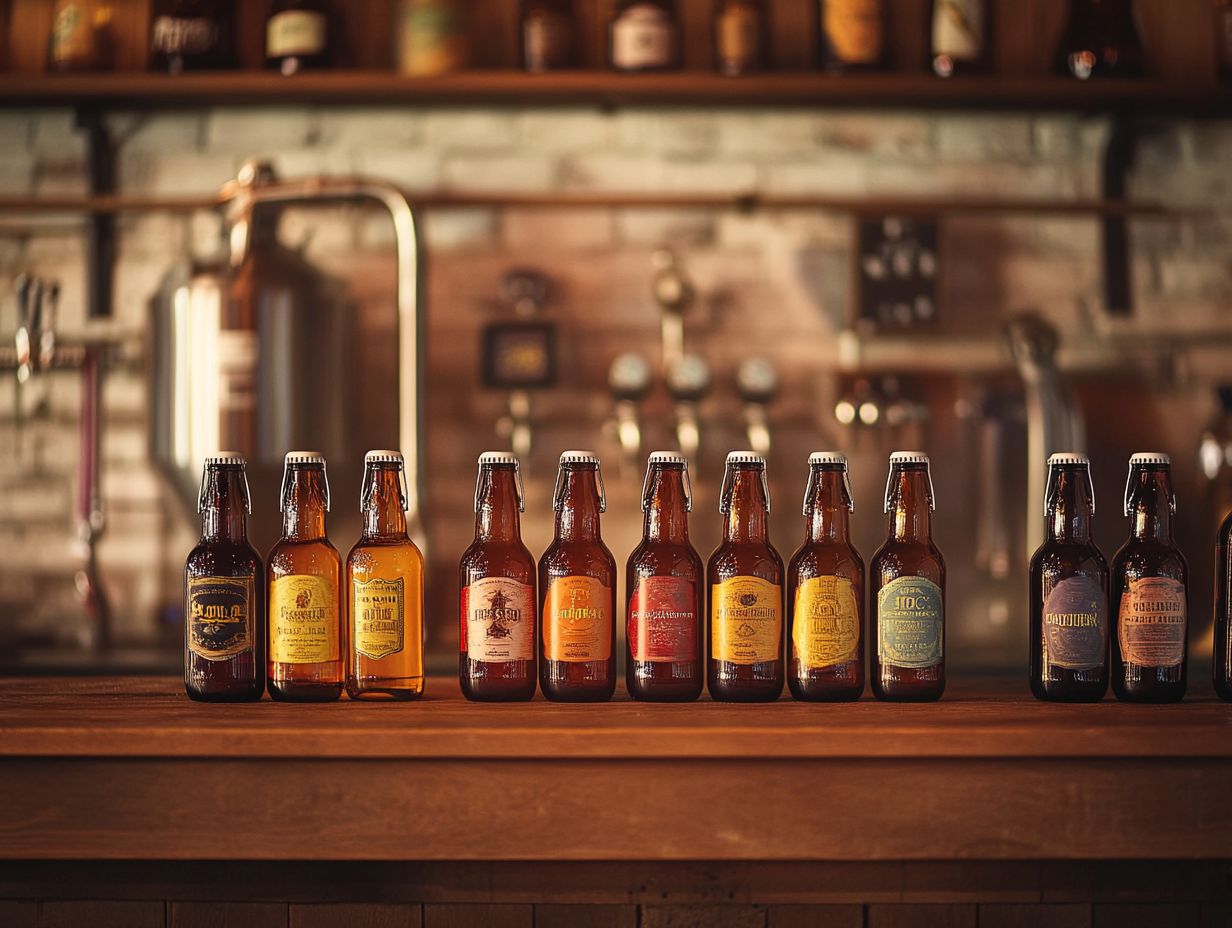
Sanitation and proper storage are absolutely essential in home brewing, as they directly impact both the longevity and quality of your beer. Proper beer storage practices ensure that your brew maintains its taste improvement over time.
To ensure success, it s vital that you thoroughly clean and sanitize all brewing equipment before use. This step prevents unwanted bacteria and wild yeasts from introducing off-flavors.
Consider using a no-rinse sanitizer to clean surfaces, fermenters, and bottling equipment; this will help eliminate any lingering contaminants that could compromise your brew.
Regarding storing your beer, aim for a cool, dark place where the temperature remains consistent. This helps preserve the flavor profile you ve worked so hard to create.
Protecting your bottles from UV light and temperature fluctuations reduces the risks of oxidation and spoilage, ensuring a truly enjoyable home brewing experience. Using a Corny keg can also help in maintaining carbonation levels.
Now that you’re equipped with the knowledge, try brewing your beer at home and share your experiences with the community!
What is the Average Shelf Life of Home Brewed Beer?
The average shelf life of your home-brewed beer can fluctuate based on a variety of factors, including the type of beer you ve crafted, its alcohol content, and how you choose to store it.
Generally, bottled beer tends to outlast kegged beer when it comes to longevity. High-alcohol varieties, like barleywines and imperial stouts, often improve with age. They develop richer flavors over time. For instance, 2004 barleywines and 2009 barleywines have shown significant taste improvement with extended aging.
In contrast, other styles may degrade in quality more quickly. It is essential for you to pay close attention to the freshness and overall quality of your brew.
1. Bottled Beer
Bottled beer tends to have a longer shelf life than kegged beer, especially when stored under the right conditions. Depending on the style and brewing techniques, it can last anywhere from several months to years. As you explore your favorites, pay attention to shelf life indicators like carbonation levels and sediment presence. These can reveal a lot about the beer’s quality and freshness over time.
Several key factors significantly influence how long bottled beer can maintain its optimal flavor and overall integrity. Proper sealing is essential; it guards against oxygen entry and minimizes spoilage risks.
You ll also want to keep an eye on carbonation levels, as they are vital for preserving the beer s effervescence. This directly affects your drinking experience.
Temperature fluctuations can greatly impact the aging process. It s crucial to store your bottles in consistent, cool conditions. By keeping an eye on these signs, you ll unlock the full potential of your brew, ensuring every sip is a delight!
2. Kegged Beer
Kegged beer typically boasts a shorter shelf life compared to its bottled counterparts. It often lasts only a few weeks to a few months, depending on storage conditions and the specific beer style. Be mindful that factors like exposure to oxygen and inconsistent storage temperatures can lead to rapid flavor degradation. This underscores the importance of careful management when it comes to kegged beer.
To enhance the quality and longevity of your kegged beer, it s essential to maintain consistent storage temperatures. Ideally, this range is between 34 F and 38 F (1 C to 3 C). This helps preserve the beer’s freshness and prevent spoilage.
Minimizing exposure to light while employing a CO2 system for serving can significantly reduce the risk of oxidation. Proper handling practices, such as avoiding unnecessary agitation during transportation and ensuring clean lines for serving, contribute to an exceptional tasting experience.
Whether it s kegged or bottled beer, these best practices can ensure that your beer maintains its quality and delivers a satisfying beer tasting experience. By keeping these factors in mind, you can ensure that each pour of kegged beer maintains its intended flavor profile.
These methods are especially crucial for homebrew enthusiasts aiming to produce top-notch results.
How Can You Tell if Your Home Brewed Beer Has Gone Bad?
To determine if your home-brewed beer has gone bad, you should conduct a meticulous examination of its appearance, aroma, and taste. These are the essential indicators of quality. Keep an eye out for any changes in color, as well as any unexpected odors or off-flavors, which can signal spoilage.
Additionally, monitoring carbonation levels is important, as irregular levels can be a sign of fermentation issues. Such issues may arise from factors like oxidation or contamination during the brewing process.
By paying close attention to these signs, you can ensure that your brewing efforts yield enjoyable results.
Assessing Home-Brewed Beer Quality
1. Appearance
The appearance of your home-brewed beer is the first signal of its quality. Watch for signs of spoilage such as excessive cloudiness, strange colors, or unexpected sediment, as these can indicate potential issues.
Familiarizing yourself with the expected clarity and color for various beer styles gives you the power to accurately assess your brew’s appearance. Using a brewing kit designed for your specific brewing styles can help you achieve the desired appearance.
For example, a well-crafted pilsner should have a bright, golden hue with crystal-clear clarity, while a stout typically showcases a deep, rich black color. If your pilsner appears murky or develops a hazy look, it could be a sign of an infection or improper filtration.
Similarly, Belgian beers like a tripel or dubbel should have a specific look that aligns with traditional brewing techniques. While some sediment in a hefeweizen might be perfectly normal, an overwhelming amount can overshadow the delightful banana and clove flavors you intended to highlight.
This is where understanding brewing traditions can be beneficial in managing expectations and identifying potential issues. Yeast produces sediment during fermentation and can create a gritty mouthfeel, detracting from the overall enjoyment of your beer.
By understanding these visual cues, you can significantly enhance your brewing experience. You will enable yourself to troubleshoot your batches and ensure that you serve only the finest creations to your eager friends and family.
Remember, sediment can impact both carbonation and beer quality, so keep an eye on it!
2. Smell
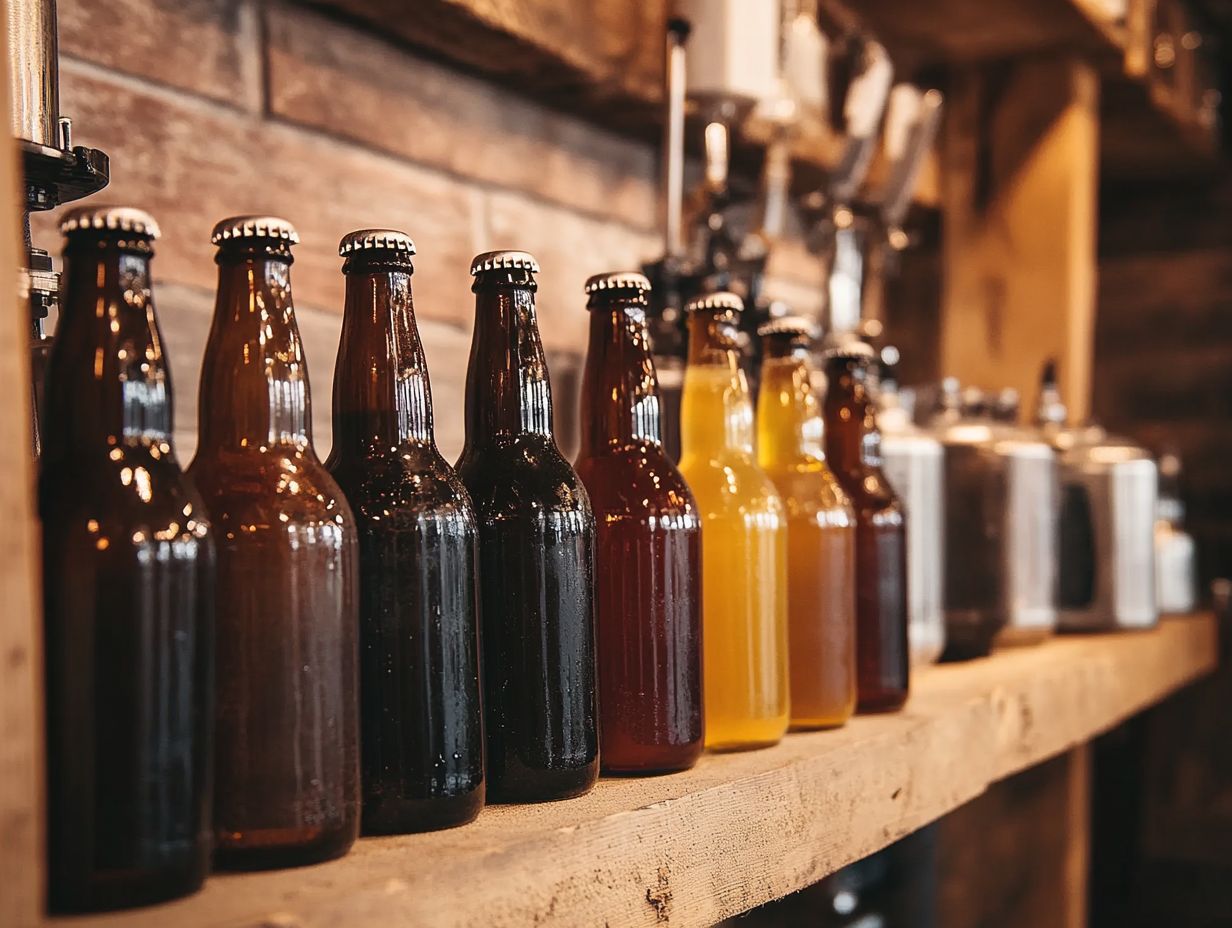
The aroma of your home-brewed beer holds essential clues regarding its quality. If you detect off-flavors or unpleasant scents, they often indicate spoilage.
Keep an eye out for vinegar-like notes or a musty smell; these can signal potential contamination or improper fermentation. Also, discern a distinctive hop aroma, which is critical for high alcohol or complex beers like an IIPA or barleywine.
A fresh brew typically presents a delightful bouquet of enticing fragrances, like floral hops, zesty citrus, or rich caramel malts. These fragrances can elevate your overall drinking experience.
When assessing the aroma, it’s crucial to be thorough, as each scent provides valuable insights into the brewing process. For beer enthusiasts, identifying these aromas can be part of the joy and skill of beer tasting.
For instance, if you pick up on a buttery note, it might suggest diacetyl, a buttery flavor that shouldn’t be present. Certain esters can impart fruity aromas that are often delightful, but if they become overly pronounced, it could point to fermentation issues.
Noting these fermentation notes can help in fine-tuning your brewing process. Taking the time to carefully evaluate these scents enhances your appreciation of the brew and serves as a diagnostic tool for ensuring quality in your brewing endeavors.
3. Taste
The taste of your home-brewed beer is arguably the clearest reflection of its quality. If you encounter off-flavors like extreme bitterness, sourness, or a stale taste, it s a strong signal of spoilage or brewing errors. By recognizing these undesirable flavors, you can make necessary adjustments for your future batches.
For more complex beers like an American wheat or bourbon barrel porter, understanding these nuances is essential. Paying close attention to these subtleties allows you to pinpoint issues that may surface during the fermentation process, such as temperature fluctuations or lapses in sanitation practices.
For example, if you detect a buttery flavorvinegar-like sourness could indicate the presence of unwanted bacteria. Monitoring these flavors can be crucial for nano brewery setups and brewing communities focused on high-quality production.
Your ability to identify off-flavors not only refines your brewing skills but also significantly enhances the drinking experience for everyone enjoying your creations. Each tasting becomes an invaluable opportunity, fostering a deeper connection between taste and enjoyment.
By doing so, you can appreciate the complexities and craftsmanship inherent in the art of brewing.
How Can You Extend the Shelf Life of Your Home-Brewed Beer?
Extending the shelf life of your home-brewed beer requires a thoughtful approach. This approach combines meticulous sanitation, effective storage techniques, and, when necessary, the strategic use of preservatives to uphold the quality of your brew over time.
Adopting best practices throughout the brewing and storage processes can significantly improve the longevity of your delicious creations. This ensures that each sip remains as delightful as the day it was crafted!
1. Proper Sanitation
Proper sanitation is absolutely crucial in home brewing. It acts as a guard against contamination that can compromise the quality of your beer and shorten its shelf life. Ensuring that all your brewing equipment, bottles, and utensils are meticulously sanitized both before and after use is essential.
Investing in good brewing equipment can also significantly contribute to the overall beer quality. If you neglect these foundational sanitation practices, you might find yourself facing a range of issues from off-flavors to spoilage that can significantly alter the taste and aroma of your final product.
Make it a point to follow specific cleaning techniques, such as utilizing a no-rinse sanitizer and washing every item that comes into contact with the wort without fail. Watch out for common pitfalls, like forgetting to clean that stray spoon or skipping the sanitation of bottles before filling.
Such oversights can introduce unwanted bacteria or wild yeast strains, jeopardizing the entire brewing process. By maintaining an immaculate brewing environment, you not only enhance the flavor of your beer but also elevate the overall experience for everyone who gets to enjoy it.
2. Proper Storage
Proper storage is essential for you to maintain the quality and extend the shelf life of your home-brewed beer. Factors such as temperature control and light exposure play significant roles in preservation.
By keeping your beer in a dark room at stable temperatures, you can reduce the risk of oxidation and maintain the integrity of its flavors. It s generally advisable to store your home-brewed beer between 45 to 55 degrees Fahrenheit, as this range helps to preserve the delicate balance of flavors and aromas.
Be aware that excessive light, especially UV exposure, can lead to unwanted flavor changes, known as skunking, which can diminish the overall enjoyment of your perfectly crafted brew. Storing in dark rooms can mitigate these risks.
Utilizing consistent storage techniques, like keeping bottles upright, helps prevent sediment disturbance, contributing to a clearer pour. By following these best practices, you can safeguard your brew against spoilage and enhance its longevity. This ensures that each sip remains as delightful as the day it was brewed!
3. Adding Preservatives
Incorporating preservatives can be an effective strategy for extending the shelf life of your home-brewed beer. This ensures that it retains its quality and freshness over time. However, it’s essential to consider how these preservatives might influence the flavor and aroma of your brew before making that decision. This is particularly relevant for aging beer or strong ales such as imperial stouts and barleywines.
You have various types of preservatives available. These include sulfites, ascorbic acid, and hop extracts, each offering distinct benefits in the brewing process. For example, sulfites are chemicals used to prevent spoilage and are excellent for inhibiting unwanted bacteria growth, though they may interfere with the beer’s natural flavors. Ascorbic acid shines with its antioxidant properties, enhancing freshness without significantly altering the taste.
Some hop extracts act as preservatives and enhance the aroma of your beer. Finding the perfect balance between extending shelf life and preserving the intended characteristics of your brew is essential for any brewer aspiring to craft the perfect beer.
Frequently Asked Questions
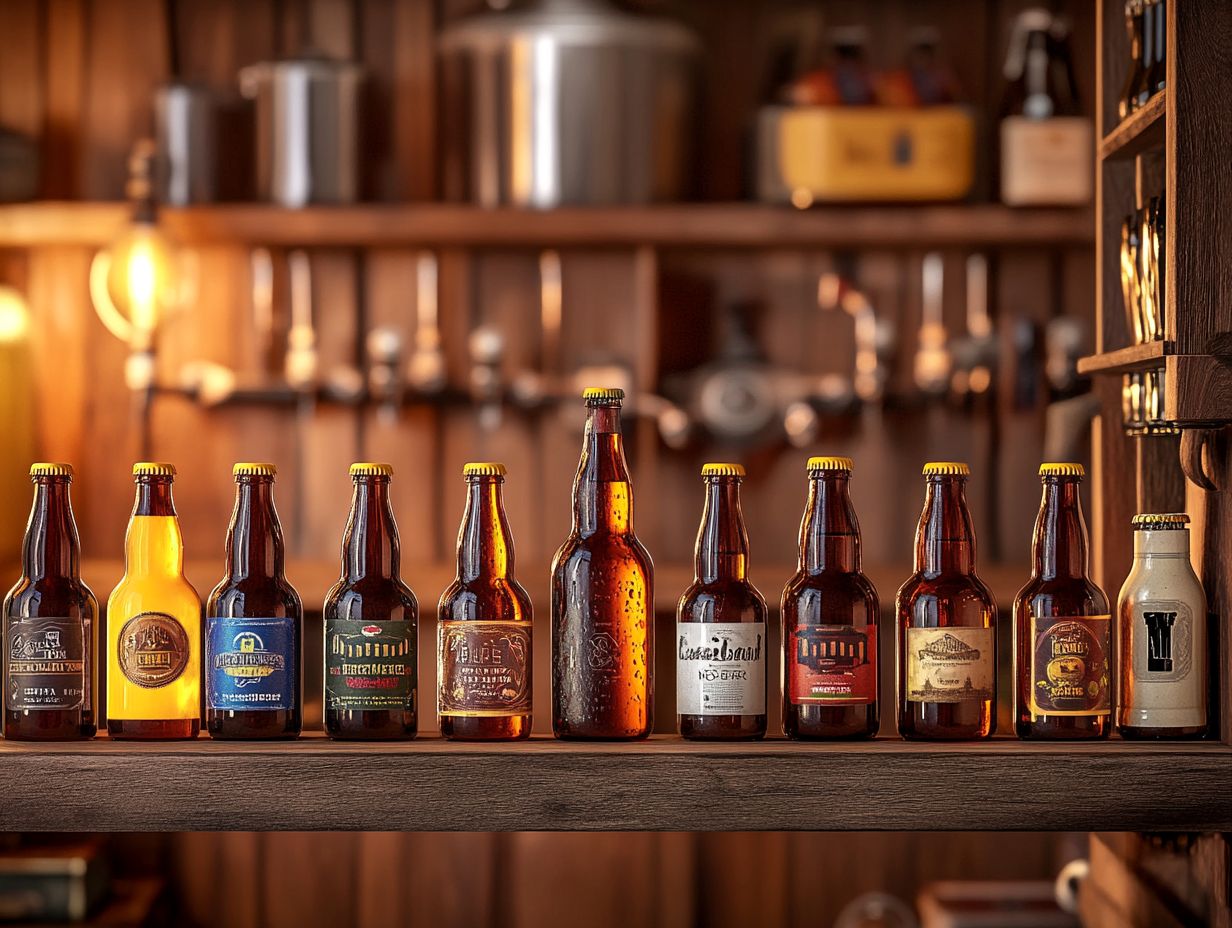
What Is the Shelf Life of Home Brewed Beer?
The shelf life of your homebrew can be influenced by various factors, including the brewing process and storage conditions. It can vary depending on factors such as storage conditions and the type of beer.
How long does home brewed beer typically last?
Some complex beers, like BWs (barleywines), can improve with age, lasting even longer. On average, home brewed beer can last anywhere from 3 to 6 months if stored properly.
What factors can affect the shelf life of home brewed beer?
Proper beer storage and monitoring shelf life indicators are crucial for maintaining quality. The main factors that can affect the shelf life include sanitation during the brewing process, oxygen exposure, and storage temperature.
Does the type of beer affect its shelf life and beer longevity?
Yes, different types of beer have different shelf lives, known as shelf life indicators. For example, lighter beers like lagers and pilsners tend to have a shorter shelf life compared to darker beers like stouts and porters, and complex beers such as Belgian beers and high alcohol beers like imperial stouts and barleywines.
How can I extend the shelf life of my home brewed beer and bottled beer?
To extend the shelf life of your home brewed beer, make sure to properly sanitize all brewing equipment and bottles. Minimize oxygen exposure during bottling and store the beer in a cool and dark room. Additionally, use best practices such as proper fermentation techniques and consider the use of bourbon barrels or plastic bottles for specific brewing styles.
What are the signs that my home brewed beer or bottled beer has gone bad?
If you notice a sour or off-putting smell, a cloudy appearance, or a strange taste, it is likely that your home brewed beer has undergone flavor degradation and should not be consumed. Other signs include changes in hop aroma and carbonation levels, which are common indicators of beer quality and longevity issues.

